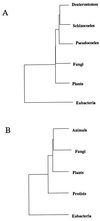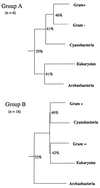Determining divergence times with a protein clock: update and reevaluation
- PMID: 9371794
- PMCID: PMC24257
- DOI: 10.1073/pnas.94.24.13028
Determining divergence times with a protein clock: update and reevaluation
Abstract
A recent study of the divergence times of the major groups of organisms as gauged by amino acid sequence comparison has been expanded and the data have been reanalyzed with a distance measure that corrects for both constraints on amino acid interchange and variation in substitution rate at different sites. Beyond that, the availability of complete genome sequences for several eubacteria and an archaebacterium has had a great impact on the interpretation of certain aspects of the data. Thus, the majority of the archaebacterial sequences are not consistent with currently accepted views of the Tree of Life which cluster the archaebacteria with eukaryotes. Instead, they are either outliers or mixed in with eubacterial orthologs. The simplest resolution of the problem is to postulate that many of these sequences were carried into eukaryotes by early eubacterial endosymbionts about 2 billion years ago, only very shortly after or even coincident with the divergence of eukaryotes and archaebacteria. The strong resemblances of these same enzymes among the major eubacterial groups suggest that the cyanobacteria and Gram-positive and Gram-negative eubacteria also diverged at about this same time, whereas the much greater differences between archaebacterial and eubacterial sequences indicate these two groups may have diverged between 3 and 4 billion years ago.
Figures



Comment in
-
Fun with genealogy.Proc Natl Acad Sci U S A. 1997 Nov 25;94(24):12751-3. doi: 10.1073/pnas.94.24.12751. Proc Natl Acad Sci U S A. 1997. PMID: 9398070 Free PMC article. No abstract available.
References
-
- Doolittle R F, Feng D-F, Tsang S, Cho G, Little E. Science. 1996;271:470–477. - PubMed
-
- Morrell V. Science. 1996;271:448. - PubMed
-
- Hasegawa M, Fitch W M. Science. 1996;274:1750. - PubMed
-
- Gogarten J P, Olendzenski L, Hilario E, Simon C, Holsinger K E. Science. 1996;274:1750–1751. - PubMed
-
- Miyamoto M, Fitch W M. Syst Biol. 1996;45:566–573. - PubMed
Publication types
MeSH terms
Substances
LinkOut - more resources
Full Text Sources

